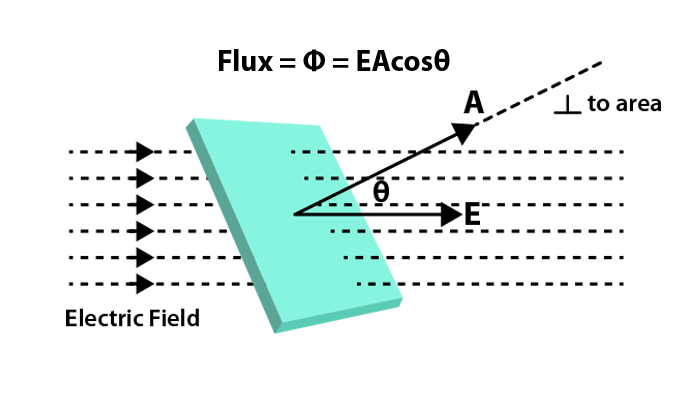
What is Electric Flux?
Nov 24, 2022, 16:45 IST
This section will discuss the concept of a electric flux, its calculation, and the analogy between electric field flux and water flux. Let us assume the flow of water with velocity (v) in the pipe in a fixed direction, say to the right. If we take the plane of the pipe cross-section and consider the small unit area given by ds from this plane, the volume flow of liquid passing through the plane perpendicular to the flow can be given as vds.
When the plane is not perpendicular to the fluid flow but is inclined at an angle θ, the total volume of fluid passing through the plane per unit of time is given by vds. cosθ. Here, dscosθ is the projected area in a plane perpendicular to the fluid flow.
The electric field is analogous to the fluid flow in the above case. The quantity we will deal with here is not as observable as the liquid we considered above. Let's understand this with the help of the image below.

Here, we can see that the electric field lines of magnitude E pass through the plane of area A, which is placed at an angle θ to the direction of an electric field.
| Table of Content |
Electric Flux Formula
The total number of the electric field lines passing a given area in the unit of time is known as the electric flux. Similar to the example given above, if the plane is normal to the flow of an electric field, the total flux is given as-
ϕ p = EA
When the plane is irregular at an angle θ, then the projected area is Acosθ, and the total flux through this surface is given as-
ϕ = EACosθ
Where,
E = Magnitude of the electric field.
A = Area of the surface through which the electric flux is calculated.
θ = The angle made by the axis and the plane that is parallel to the direction of flow of an electric field.
Unit of Electric Flux
- V . m
- Nm m²C⁻¹
- Base unit: Kg. m³s⁻³A⁻¹
Dimensional Formula of Electric Flux
ϕE = Unit of E x Unit of S
= NC⁻¹m²
= MLT⁻² L² AT⁻¹
Dimensional formula of ϕE = M L ³ T ⁻³ A ⁻¹
Frequently Asked Questions (FAQs)
Q1. What is an electric flux?
Ans. The total number of the electric field lines passing the area in a unit of time is known as electric flux.
Q2. What is the basic nature of an electric field line?
Ans. An electric field line originates on a positive electric charge and also terminates on a negative charge.
Q3. What is the connection between the electric flux and Gauss’s law?
Ans. The mathematical relationship between the enclosed charge and the electric flux is called Gauss’s law.
Q4. What is the unit of electric flux?
Ans. The unit of electric flux is voltmeters (V.m).
Q5. What factors affect electric flux?
Ans. The numerical value of the electric flux usually depends on the magnitudes of an electric field, the area, and the relative orientation of the area concerning the direction of an electric field.









